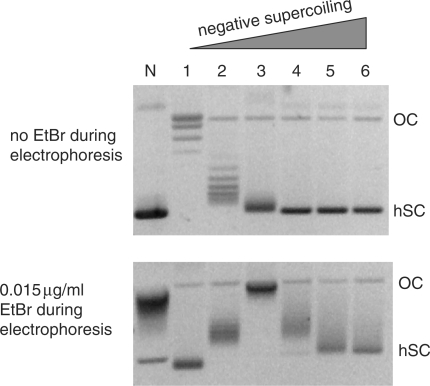Figure 3.
Characterization of pCG14 plasmids with various levels of negative supercoiling. Lane N corresponds to plasmid with native supercoiling. Lanes 1–6 show plasmid samples treated with calf thymus Topo I in the presence of increasing amounts of EtBr and consequently having increased negative supercoiling. The concentrations of EtBr during incubation were 0 μg/ml, 1.25 μg/ml, 2.5 μg/ml, 5 μg/ml, 7.5 μg/ml and 10 μg/ml for lanes 1, 2, 3, 4, 5 and 6, respectively. To resolve the samples at lower superhelical densities, gel electrophoresis was performed in the absence of EtBr (upper panel). To resolve the samples at higher superhelical densities, gel electrophoresis was performed in the presence of 0.015 μg/ml EtBr (lower panel). OC (open circles) designates nicked plasmids which migrate close to relaxed circular closed plasmid, and hSC designates highly supercoiled plasmids. In the absence of EtBr (upper panel), the higher the negative superhelical density of the plasmid, the faster it migrates in the gel. The minimum mobility corresponds to relaxed plasmid (lane 1). Starting from some superhelical density, the mobility reaches saturation, and the plasmid samples are not resolved (lanes N, 4, 5 and 6). Binding of EtBr to the circular closed plasmid introduces positive supercoiling into the plasmid, the magnitude of which depends on EtBr concentration. In the presence of EtBr (lower panel), plasmid in lane 3 has the lowest mobility, close to the mobility of open circles (OC), which means that the negative supercoiling in this plasmid is almost exactly compensated by positive supercoiling introduced by EtBr. Plasmids with less negative supercoiling than those in lane 3 (lanes 1 and 2) in the presence of EtBr become positively supercoiled, and plasmids with higher negative supercoiling than for lane 3 (lanes N, 4, 5 and 6) in the presence of EtBr remain negatively supercoiled, but with somewhat lower superhelical density, which allows better resolution. It can be seen that the native superhelical density (lane N) is close to the superhelical density of the plasmid in lane 3.

